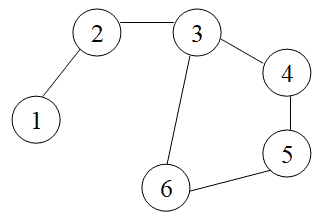Learn through the super-clean Baeldung Pro experience:
>> Membership and Baeldung Pro.
No ads, dark-mode and 6 months free of IntelliJ Idea Ultimate to start with.
Last updated: March 18, 2024
In this tutorial, we’re going to learn to detect cycles in an undirected graph using Depth-First Search (DFS).
A graph is a data structure that comprises a restricted set of vertices (or nodes) and a set of edges that connect these vertices.
We can define a graph , with a set of vertices
, and a set of edges
. Every edge connects two vertices, and we can show it as
, where
and
are connected vertices.
For example, if there is an edge between two vertices and
, then we call them associated. We can then also call these two as adjacent (neighbor) vertices.
Mathematically, we can show a graph ( vertices,
edges) as:
We can categorize graphs into two groups:
First, if edges can only be traversed in one direction, we call the graph directed.
For example, if a directed edge connects vertex 1 and 2, we can traverse from vertex 1 to vertex 2, but the opposite direction (from 2 to 1) is not allowed. So, we can say that is not equal to
.
But, if the edges are bidirectional, we call the graph undirected.
For example, if an undirected edge connects vertex 1 and 2, we can traverse from vertex 1 to vertex 2 and from 2 to 1. We can then say that is equal to
.
In graph theory, a path that starts from a given vertex and ends at the same vertex is called a cycle.
Cycle detection is a major area of research in computer science. The complexity of detecting a cycle in an undirected graph is .
In the example below, we can see that nodes 3-4-5-6-3 result in a cycle:

Next, then, let’s learn how to detect cycles in an undirected graph. Specifically, let’s use DFS to do it.
As a quick reminder, DFS places vertices into a stack. We start with some vertex and push it onto the stack. Then:
Now, to detect a cycle, we can adjust DFS’s logic a bit: If has a visited neighbor
that:
then we’ve got a cycle.
Putting this into pseudocode, we get:
algorithm detectcycle(v_n):
// INPUT
// v_n = current vertex in G
// OUTPUT
// true if a cycle is found; otherwise, returns false
mark(v_n, visited)
for u_n in neighbors(v_n):
if mark(u_n) = visited:
if v_n = u_n or u_n != parent(v_n):
return true
else if detectcycle(u_n):
return true
return false
And now we can use it to detect cycles in undirected graphs by calling .
In this quick tutorial, we explored how to detect cycles in undirected graphs – basing our algorithm on Depth-First Search.